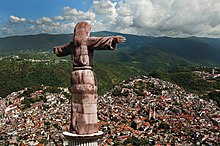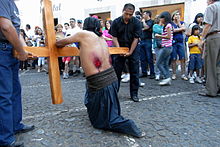Taxco
Taxco, Guerrero | |
|---|---|
| Taxco de Alarcón | |
 Top, from left to right: Overview of Taxco, The Monumental Christ of Taxco, Santa Prisca Temple (Templo de Santa Prisca), Church of the former monastery of San Bernardino de Siena, La Santisima Church, Museum of Viceregal Art, The House Borda and Plaza de Armas kiosk. | |
|
UTC-5 (Central) | |
| Postal code (of seat) | 40200 |
| Area code | 762 |
| Website | www |
Taxco de Alarcón (Spanish:
The city is heavily associated with silver, both with the mining of it and other metals and for the crafting of it into jewelry, silverware and other items. Today, mining is no longer a mainstay of the city's economy. The city's reputation for silverwork, along with its picturesque homes and surrounding landscapes, have made tourism the main economic activity.
History
The name Taxco is most likely derived from the

Before the arrival of the Spanish in Mexico, the indigenous community known as "Taxco" was not located where the modern city is now. The name referred to a village about ten kilometers to the south, which is now referred to as
Mining here began in the pre-Hispanic period with natives extracting a number of stones for decorative and ritual purposes.[1] The Spanish discovered silver lodes here in around 1532, which started commercial silver mining in the area.[3] Mining operations in the area during the early colonial period was carried out mostly by mining haciendas such as the
For most of the colonial period, the area was sparsely populated, including the town of Taxco itself. For this reason, it was governed as a dependency of Mexico City. When the modern state of Guerrero was created in 1850, Taxco was chosen to be the seat of the municipality of the same name. Since it was the only town of any size in the area, the town was taken a number of times during a number of different conflicts. During the Mexican War of Independence, it was taken by
Silversmithing was reinvigorated in Taxco by American William Spratling, who moved to the town in the 1920s, creating silver design workshops and exported items, mostly to the United States.[5] With its fame for silversmithing, tourism became a major economic force in Taxco.
In March 2024, three adults were beaten (one fatally) by a
Geography
Taxco is located in the north-central part of the state, 36 kilometres (22 miles) from the city of Iguala, 135 kilometres (84 miles) from the state capital of Chilpancingo and 170 kilometres (106 miles) southwest of Mexico City.
Climate
The climate in Taxco is mild, with average highs around 27 °C (81 °F) and average lows around 17 °C (63 °F) year-round.[8] The dry season lasts from November to April, with rains typically occurring from June to September.[8]
Demographics and development
Taxco's population as of 2010[update] was 52,217 (in 13,933 households), of whom 48% were men and 52% were women.[9][10] Taxco's population grew rapidly from 1950 (10,023) to 2000 (50,488).[10]
Taxco's development indicators are fairly good relative to other towns and cities in Mexico.[11][12] As of 2010[update], approximately 38% of residents aged 15 and over lacked a basic education (including 17% who did not finish primary education), and approximately 6% of residents aged 15 and over were illiterate.[11][12] Approximately 87% of homes had refrigerators, and 51% had washing machines.[12] Approximately 8% of homes lacked piped water, and 5% had a dirt floor.[11][12]

| Population of Taxco, 1900-2010 |
 |
| Source: Instituto Nacional de Estadística y Geografía.[10] |
Economy and transportation



Silverwork and tourism related to Taxco's status as a silver town is the mainstay of the economy.
Taxco lies along Mexican Federal Highway 95 and the toll road Mexican Federal Highway 95D. Taxco has two long-distance bus stations: the Terminal Estrella de Oro in the south and the Autobuses Estrella Blanca station in the northeast. There is no airport in Taxco. Transport within Taxco is generally by taxi, or "Kombis"—converted Volkswagen vans that serve as minibuses.[17]
Influential Silver Designers
Taxco was home to many influential and popular designers and silversmiths specifically in the early and mid 20th century. One of the most prominent figures in popularizing Taxco silver was the famous American artist and architect William Spratling. Spratling discovered Taxco in 1929[18] and was amazed by the artisanal traditions and craftsmanship employed by the local silversmiths. Prior to Spratling's arrival, Taxco was mostly a silver mining town but was not known for silver designing. He visited the nearby town of Iguala and enlisted the help of master silversmiths Artemio Navarrete, Alfonso Mondragón, and Wenceslao Herrera[19] Spratling's first workshop was set up on Calle de Las Delicias in Taxco. Some modern day designers including Reveka Rose and AtomicDrip still employ original techniques popularized by Spratling and his students to create modern day pieces with silver sourced from Taxco. Today, over 3,000 silversmith artisans call Taxco home. This is a testament to the influence that Spratling had on making Taxco the proclaimed Silver Capital of the World. [20]
Cityscape and historic buildings

The city of Taxco lies on very rugged terrain and has steep, irregular streets. The streets are also narrow and generally lack sidewalks, making them picturesque but dangerous. Adding to the charm is that most streets are paved with dark stones, adorned with lines, pictures and even murals of white stone. Some of the pictures in the street are from the Zodiac and meant to indicate certain commercial activities in times past. One example of this is the sign of Taurus near the Church of Santa Prisca, which used to indicate the area of butcher shops. Buildings in the city typically have Spanish-style, red-tile roofs.[15]
The town's main plaza, officially called Plaza Borda after José de la Borda, is commonly referred to as the Zócalo. On the north side of this plaza is the Casa Borda (Borda House), the most important non-religious construction in the city. The front facing the Zócalo has two stories, but the back, facing the Plaza de Bernal, has five. This is due to the uneven ground on which the house was built. Much of the house is now dedicated to the Casa de Cultura (Cultural Center) where classes in languages, fine arts and sports such as judo are taught. The rest of the main plaza is surrounded by silver shops, restaurants and bars.[15]
The
Near the main plaza are two museums: the
Two other churches of note are the Church of the former monastery of San Bernardino de Siena, and the Church of Veracruz. The Church of the former monastery of San Bernardino de Siena is the oldest in the area, constructed at the end of the 16th century and restored in the 19th after a fire. This convent's orchard is now the garden of the Posada San Javier Hotel.[15] The Church of Veracruz is located on the Plazuela de la Veracruz on Juan Ruiz de Alarcón. Its principal attraction is an image of Christ which is nicknamed "The General". This plaza is one of three that house monuments to the playwright Juan Ruiz de Alarcón, who was born in a house near here.[13]
On the north side of town is one of the major colonial period silver haciendas, the Ex Hacienda del Chorrillo. The hacienda was constructed by knights of Hernán Cortés and is one of the oldest in the region. Its aqueduct, built in 1534, is partially preserved.[4][13]
Culture

Other notable events include the San Antonio Abad Festival in January, the Jornadas Alarconianas (Alarconian Days) in May, the Jumil Festival in October, and the National Silver Fair in late November and early December.[22]
Basketball is the most popular sport in Taxco Municipality.[citation needed] In the city of Taxco, there are basketball, volleyball, and tennis courts, as well as soccer fields.[1]
Landmarks
-
Statues about Good Friday Procession in Taxco
-
San Juan Little Square
-
De Chavarrieta Parish
-
Casa Borda corner towards Plaza Borda
-
Guerrero Square and La Santisima Church corner
-
Old City Hall
-
Zoofari Safari
-
Church of the former monastery of San Bernardino de Siena
-
La Santisima Church
-
Museum of Viceregal Art. It features Spanish era artifacts
-
Plaza Borda
-
The Saint Nicholas of Tolentino Church
-
San Nicolás Little Square
-
Abandoned hacienda in Taxco outskirts
-
Typical monumental pedestrian steps from Taxco
References
- ^ a b c d e f g h i "Guerrero:Taxco de Alarcón". Enciclopedia de los Municipios de Mexico (in Spanish). Archived from the original on 2007-05-27.
- ^ a b c Allen, Jim; Jan McHargue. "Silver, Saints, and Sinners: Semana Santa in Taxco, Mexico". Mexconnect. Retrieved 2009-08-26.
- ^ West, Robert (1997). "Early Silver Mining in New Spain, 1531-1555". In Bakewell, Peter (ed.). Mines of Silver and Gold in the Americas. Aldershot: Variorum, Ashgate Publishing. pp. 57, 61–64.
- ^ a b "Vestigios de una antigua fundición de plata" (in Spanish). Mexico Travel Club. Archived from the original on 2009-11-30. Retrieved 2009-08-26.
- ISBN 978-0-8263-2805-2.
- ^ Rocha, Leonardo (29 March 2024). "Mexico: Funeral held for girl whose death sparked mob violence in Taxco". BBC News. BBC.
- ^ Kelly, Kieran (30 March 2024). "Murder suspect 'beaten to death in street by mob of protestors' after girl, 8, killed in Mexico". LBC News. LBC.
- ^ a b "Normales climatológicas 1971-2000, estación 00012122 (Taxco, Taxco)" (in Spanish). Servicio Meteorológico Nacional. Archived from the original on 2010-04-27.
- Secretariat of Social Development. Retrieved October 24, 2015.
- ^ a b c "Archivo histórico de localidades". Instituto Nacional de Estadística y Geografía. 2005. Archived from the original on October 29, 2013. Retrieved October 27, 2013.
- ^ Secretariat of Social Development. Retrieved October 24, 2015.
- ^ Secretariat of Social Development. Retrieved October 24, 2015.
- ^ ISSN 0188-5146.
- ^ "Cierra Minera México unidad en Taxco, Guerrero" (in Spanish). Mexico City: El Universal. 2007-09-25. Retrieved 27 August 2009.
- ^ a b c d e f g h Valtierra, Angel. "Fin de Semana in Taxco" (in Spanish). Mexico Desconocido. Retrieved October 24, 2015.
- Secretariat of Tourism. Retrieved October 24, 2015.
- ISBN 978-0-7645-8775-7.
- ^ "William Spratling's Legacy in Taxco's Silver". Lolo - Modern Mexican Mercadito. Retrieved 2024-03-27.
- ^ "William Spratling's Legacy in Taxco's Silver". Lolo - Modern Mexican Mercadito. Retrieved 2024-03-27.
- ^ "William Spratling's Legacy in Taxco's Silver". Lolo - Modern Mexican Mercadito. Retrieved 2024-03-27.
- ^ "Destinos en Mexico: Semana Santa en Taxco, Guerrero" (in Spanish). Terra. Retrieved 2009-08-26.
- ^ "Don't Miss, Taxco de Alarcon, Guerrero". Mexico Tourism Board. Retrieved October 24, 2015.
- ^ "Cuisine in Taxco". Mexican Tourism Board. Retrieved October 24, 2015.
- ^ "Taxco's exotic delicacies". Mexico Tourism Board. Retrieved October 24, 2015.
- ^ Ochoa, Olga (December 8, 2010). "Sabores de Taxco". El Universal (in Spanish).
- ^ "El destino del mes. ENERO 2012. TAXCO, GUERRERO". www.conaculta.gob.mx.
- ^ Karen Hursh Graber. "Queso Mexicano: A Guide to Mexican Cheese".
External links
 Media related to Taxco de Alarcón at Wikimedia Commons
Media related to Taxco de Alarcón at Wikimedia Commons Taxco travel guide from Wikivoyage
Taxco travel guide from Wikivoyage
















